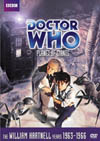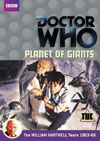DVD Extras include:
Episode One - Planet of Giants - directed by Mervyn PinfieldThe TARDIS makes its third materialization in the history of the show, and sadly does so without the sound effect again. Apart from that, this episode is quite well done technically. The drama is fairly well written and satisfactorily directed and acted out - nothing too spectacular though. The mystery begins as the materialization goes awry (in more ways than one), and soon leads our travellers to explore outside with curiosity and keen observation. This is the right idea, but somehow it isn't as riveting as in "The Dead Planet" (first episode of story no. 2). Still, it's pretty good.The sets, props, and effects are quite convincing, making the "Honey, I Shrunk the TARDIS" idea very believable, but Ian and Susan react to things a little less than believably. The Farrow character seems a little aimless at first, until Forester shows up and the two have a dramatic little scene. Some of their lines have the feel of being contrived to support the plot, but the ones that work are delivered with good conviction by Farrow. One has to ponder the method of shrinkage, since chemistry plays such a strong role in this story. Two popular theories are that (1) you reduce the amount of space between atomic particles to reduce the size of a person's molecules, or (2) you reduce the number of atoms and molecules that a person is composed of. All things considered, I believe the four time travellers are walking around with fewer atoms. The "missing" (and uninfected) atoms are probably scattered across several phased dimensions along with much of the TARDIS interior. Their conscious minds and souls have been projected and focused in their entirety into the tiny bodies that leave the TARDIS for this adventure. This would allow fairly normal chemical interaction between the characters and their environment, which is important for the story. Although the shrinking concept makes this story unique, other stories have featured similar shrinkages: "Carnival of Monsters" (story no. 66), "The Invisible Enemy" (story no. 93), and "The Armageddon Factor" (story no 103) to name a few. Also in later years, the favourite weapon of the Doctor's arch enemy, the Tissue Compression Eliminator, involves shrinkage. This device reportedly reduces the space between atomic particles, which is usually fatal in the Doctor Who universe. One could also consider the planet Zanak from "The Pirate Planet" (story no. 99) as a similar device - definitely reducing space between atoms as the shrunken planets retain their enormous mass/weight. The mass/weight of the four time travellers appears to be proportionally reduced in this story - further support of the "missing atom" method. This story introduces composer Dudley Simpson to the series, who will become its most prolific creator of background music. His debut score is quite a bit different to the very successful style he will eventually settle into during the Tom Baker era, sounding here much closer to 1960's family movie music. Most cues seem to fit the story well enough, but have been dubbed in to the studio taping a bit too loudly, causing them to pop out of the background a bit too much and compete with the dialogue. A few cues that have the auditory center-stage to themselves bring a musical mood to the story that is just a bit too quaint and cute, while the characters' dialogue and expressions convey worry, fear, apprehension, and tension. In episode one, this includes the mid-episode reveal of the location's true nature and the cliffhanger. Not as supportive a combination as I would think is possible. By the time the cliffhanger comes along, the drama seems contrived and devoid of true danger or suspense.
Episode Two - Dangerous Journey - directed by Mervyn PinfieldThe TARDIS crew is soon split up, and it seems at first that the Doctor and Susan will have the interesting and heroic bits since Ian and Barbara need rescuing. Not so. Ian and Barbara have all the best scenes as they investigate the lab and begin to unravel the environmentally-friendly sci-fi plot concerning the insecticide DN6. The Doctor and Susan's cameos are basically transitional. Smithers enters the "large person" plot, and appears to be the most contrived character so far in terms of having believable motives. Again, this episode is okay, but not spectacular. The cliffhanger works better than the previous one, though it still lacks a certain immediacy.
Episode Three - Crisis1st half - the old episode 3: Crisis, directed by Mervyn PinfieldCompressed into half of its original time-frame by order of Verity Lambert, the pace is about right during Mervyn Pinfield's contribution to this episode. What exactly was cut out? It's not hard to imagine a repeat of the dead air-time problem that still plagues "The Sensorites" (story no. 7, by the same director), or a few scenes of Smithers griping about the same things as he did last episode, again without any of it leading anywhere. I think I would have to agree with the producer's call to pare Mervyn Pinfield's work down.2nd half - the old episode 4: An Urge to Live, directed by Douglas CamfieldThis story was also fortunate in introducing Douglas Camfield to the Doctor Who series as a director proper. (He had previously shot some short film sequences for Doctor Who's first story.) Although still a very new director at the time, his track record would later rank among the very best of all Doctor Who directors, if not THE best. Was it wise to pare down HIS work on the original fourth episode of this story? I believe there was still plenty of unnecessary padding in the script, but Camfield has a way of filling time with truly interesting shots and sequences, adding atmosphere, etc. Somehow, some things do seem to be missing from this half of the episode. We cut into the middle of an argument amongst the four characters, where someone insists that Barbara is (W)right. (W)right about what? The dialogue doesn't say, because it has already said so in the pieces now on the cutting room floor, but eventually the point is made. The pair at the switchboard suddenly mention a blue car, as though it was a clue we should recognize, but it was never introduced. The novelization by Terrance Dicks reveals another element - the cat dies of DN6 in the last episode, and this is the discovery that finally turns Smithers' loyalty around. Was it shot that way too? Did the scene get cut?All in all, the compressed episode still works, going where Doctor Who always should - into the hero department. Barbara demonstrates the most bravery, picking herself up from her low-point and risking her life for her beliefs, and the Doctor is right behind her, having learned from her example in the past and beginning to put his own actions where his true inner beliefs are. The pace allows the four time travellers to accomplish a great deal in a mere half-hour episode, and the DN6 plot has an amazingly well done resolution. The master-director is IN! Dudley Simpson's music is much less prolific in the final half-episode, its jolly quaintness being replaced by long, single moody notes which now fit the ominous feelings our time travellers have about their grave and dangerous situation. Or is that "the Tone" from the telephone, slowed down of course, which our switchboard operator doesn't have a chance to introduce properly now that one of her scenes has been cut? Unfortunately, Douglas Camfield still allowed music to totally replace the TARDIS sound effect during the visual dematerialization. TARDIS standards were not yet in force. But is it a proper dematerialization or a re-phasing of the TARDIS' dimensions? Note the inactivity of the central column on the console during and just after the police box fades away. After the size issue is solved, the Doctor operates the controls again, and the sound effect returns. Or is this a premature landing in London, 2164? All the right elements are present, just not done in sync this time around.
International Titles:Deutsch: (Planet der Riesen)
This story has become available on DVD and VHS video. Click on the Amazon symbol for the location nearest you for pricing and availability:
Comments on this article are welcome. You may contact the author from this page:
|








